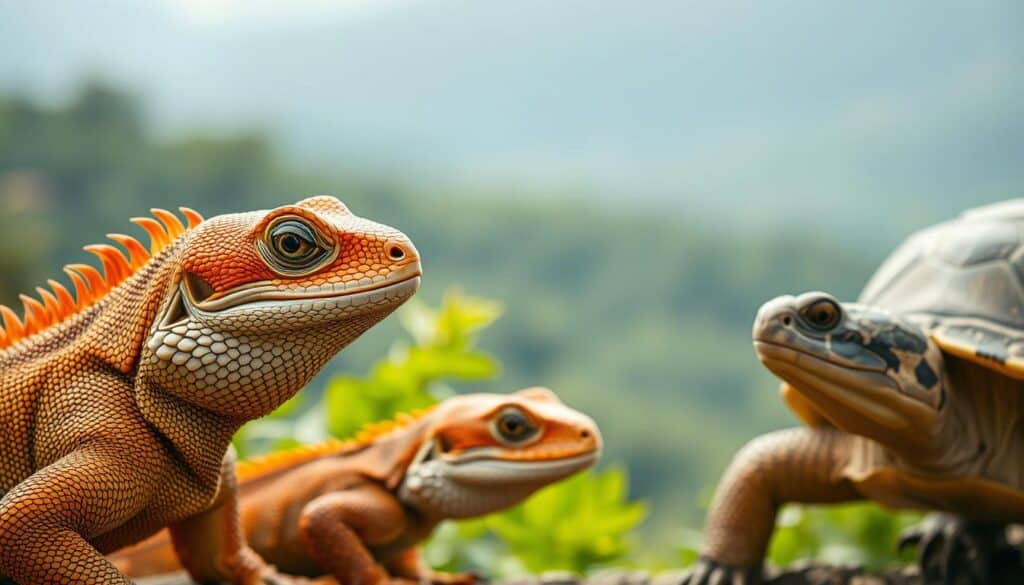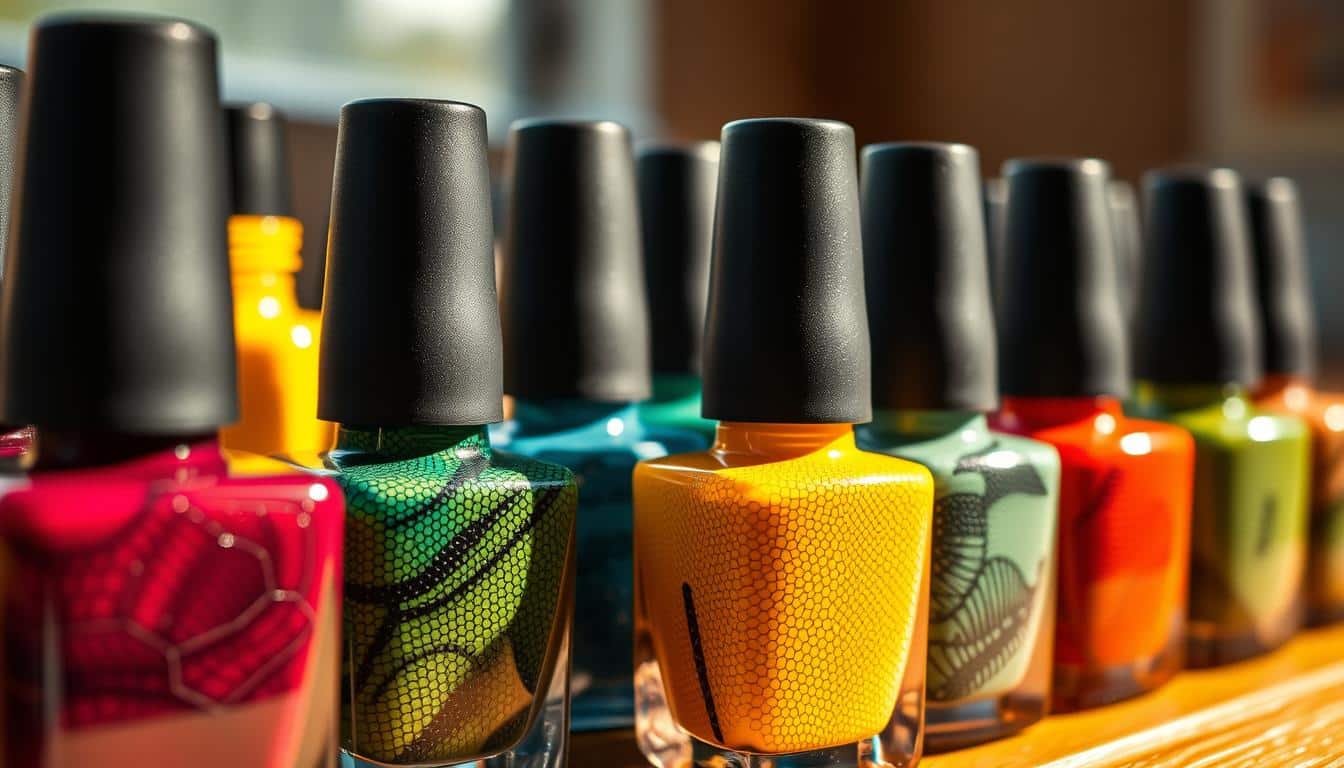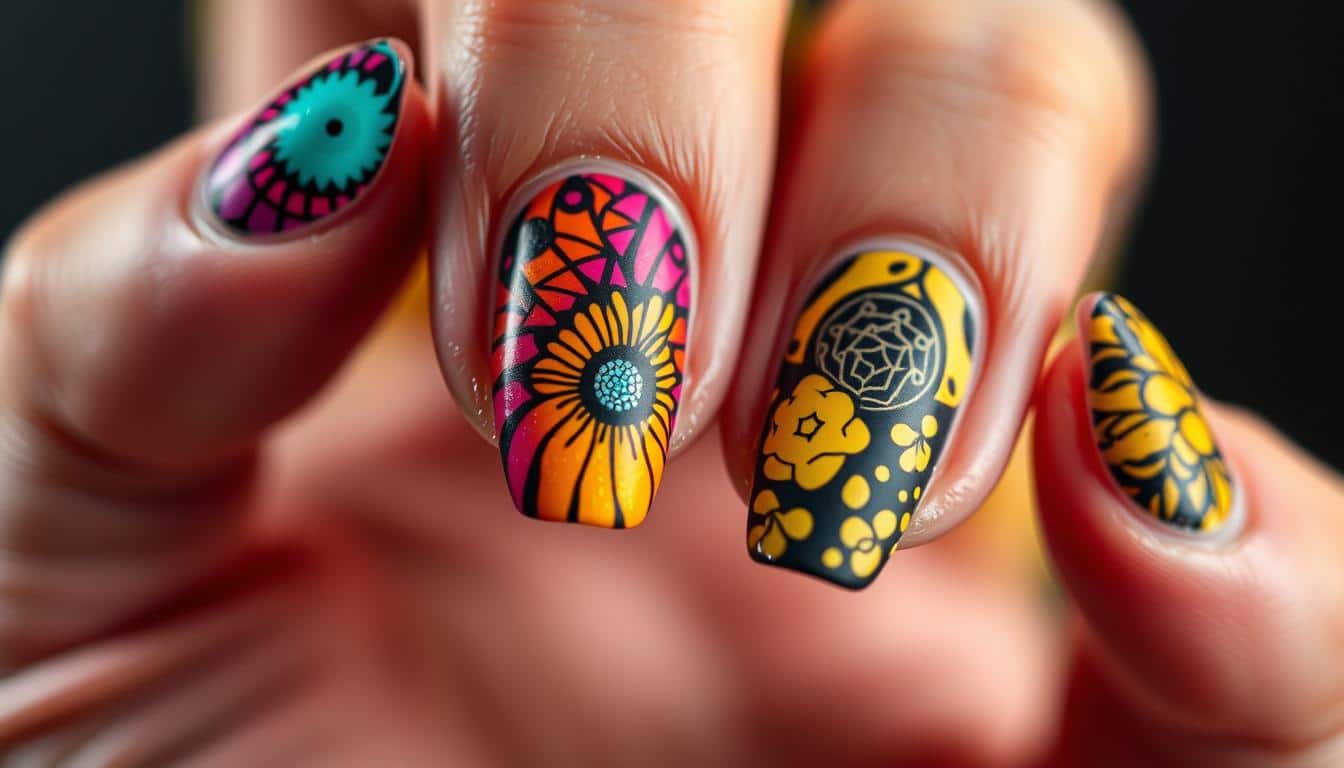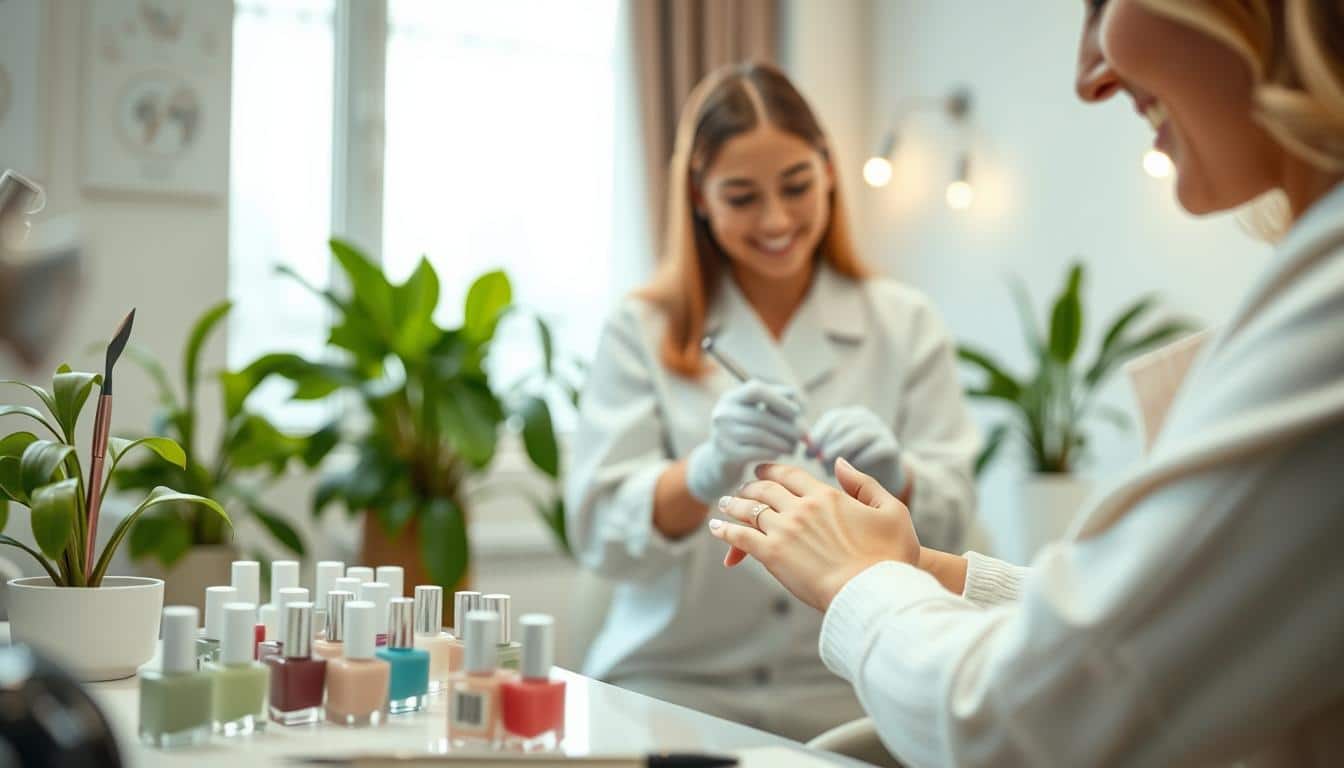Anúncios
Welcome to the ultimate guide on Reptile Care & Nail Polish Safety. It’s crafted for pet lovers who cherish their reptiles. Whether you’re skilled in reptile care or just starting, it’s crucial to know how to look after them. A vital point often missed is the danger nail polish poses to reptiles, such as bearded dragons.
This guide will highlight how special our reptilian pets are. It aims to ensure they get the care they deserve while keeping them safe from harmful chemicals in cosmetics. Let’s dive into maintaining your reptile’s health and making sure your beauty routines don’t harm them.
Understanding Reptiles as Pets
Having reptiles as pets is a special experience, different from having usual pets. These creatures are fascinating because of their unique needs. Unlike mammals, reptiles rely on their surroundings to stay warm. It’s important for their owners to make sure their living space has the right temperature.
To take good care of reptiles, you need to know about their home needs. For instance, they need certain levels of humidity and sunlight to be healthy. These things help them feel their best.
Reptiles act on both instinct and what they learn. Even if they grow up as pets, they keep some wild behaviors. This affects how they get along with others and their eating habits. Watching these behaviors helps pet owners understand how to make a better home for them.
Essentials of Reptile Care
Proper care for reptiles includes several key parts that greatly affect their health. One important part is a well-set-up habitat. This makes a cozy living area for them. The space must be big enough for your reptile species, allowing it to move and bask comfortably.
Temperature and humidity are crucial too. They must be kept at the right levels to keep your reptile healthy.
Feeding your reptile the right food is also very important. Each species has different needs, with some eating live food and others eating plants. A good diet helps prevent sickness.
Don’t forget about regular health checks. They help spot problems like shedding issues or diseases early. Watching your reptile’s behavior and looks closely helps catch health issues quickly.
Nail Polish and Reptile Safety Concerns
For reptile owners, understanding nail polish safety is key. Reptiles have thin, sensitive skin that easily absorbs chemicals. This makes them vulnerable to harmful substances found in many nail polishes.
Pet owners must know the dangers of using nail polish around reptiles. The main risks include:
- Skin irritation or burns from strong chemicals.
- Respiratory problems from polish fumes.
- Long-term health issues from ingesting toxic chemicals.
To keep your reptile healthy, ensure their living space is clean and safe. Be careful not to use nail polish near them. Also, store all beauty products where your pets can’t reach them.
Reptile Care and Nail Polish Compatibility
Reptile owners must think about how nail polish affects their pets. Some nail polish has chemicals that could be harmful to reptiles. Knowing what’s in your nail polish helps keep reptiles safe.
Effects of Chemicals in Nail Polish
Nail polish has chemicals that might not be good for reptiles. Toluene can hurt their nervous system. Formaldehyde, used to keep polish fresh, can harm reptiles’ skin and breathing. Phthalates, which make the polish flexible, could upset the reptiles’ hormones. It’s important to know this to keep your reptile safe.
Common Ingredients to Avoid
Be careful when choosing nail polish if you have reptiles. Stay away from these harmful ingredients:
- Toluene
- Formaldehyde
- Phthalates
- Camphor
- Parabens
Picking nail polish without these ingredients is better for reptile safety. Always read the labels. Choose brands that use safer ingredients to help your reptiles live well.
Caring for Your Bearded Dragon
Bearded dragons need the right environment and diet to be healthy. It’s important to set up their habitat correctly and feed them properly. They do best when their home feels like their natural habitat.
Habitat Setup and Environment
To make a great home for bearded dragons, include the right temperatures, UVB light, and humidity. Here’s what you need:
- Enclosure Size: Adult bearded dragons should have at least a 40-gallon space.
- Temperature Gradients: Have a warm basking spot of 100-110°F and a cooler area of 75-85°F.
- UVB Lighting: A high-quality UVB bulb is necessary for vitamin D3 production, which helps with calcium absorption.
- Humidity Levels: Keep humidity at 30-40% to avoid health problems. Too much moisture is bad.
- Substrates: Use reptile carpet or ceramic tiles to avoid any risk of your dragon eating the substrate.
Dietary Needs and Supplementation
Bearded dragons need a variety of foods to stay healthy. Here’s how to feed them:
- Insects: Offer crickets, dubia roaches, and mealworms for protein.
- Vegetables: Provide leafy greens and squash for their diet.
- Supplements: Regularly give calcium and vitamin D3 supplements, especially to young dragons.
- Feeding Frequency: Feed young dragons 2-3 times a day and adults every other day.
Recognizing Signs of a Healthy Reptile
It’s key for every reptile owner to know what a healthy reptile looks like. Signs such as clear eyes, eating well, and being active are good. Checking your pet regularly helps spot these signs. A reptile that moves around a lot and interacts with its surroundings is usually healthy.
Shedding is also crucial to watch. When reptiles shed their skin right, it means they’re growing and healthy. Watching how your reptile sheds can tell you a lot about its health.
However, spotting signs of sickness is just as key for quick help. Watch for:
- Not eating much
- Being less active
- Shedding in odd ways
- Swelling or weird lumps
- Color changing
By being alert to these sickness signs, owners can get vet help fast. This means better health for your reptile. Paying close attention to how your pet acts and looks is proactive health care. It makes their life better.

Cleaning and Maintenance for Reptile Habitats
Keeping a clean home is vital for reptile health. Cleaning their homes regularly keeps them safe from bad bacteria and parasites. It also helps keep their living area nice and tidy.
You should remove uneaten food, waste, and dirty bedding every day. This keeps the area clean and stops diseases.
Each week, do a thorough clean. Take out all decorations, bowls, and bedding. Use safe cleaners to wash everything well. Make sure everything is dry before putting it back.
- Pick cleaning products made for reptile homes.
- Deep clean the whole home every few months.
- Keep an eye on humidity and temperature for cleanliness.
Clean habitats mean healthier reptiles. It helps them live happily and makes owning reptiles more fun. Regular cleaning keeps their space fresh and safe.
Best Practices for Handling Reptiles and Personal Safety
Handling reptiles requires a thoughtful approach. It’s about keeping both you and the animal safe. Knowing how reptiles behave helps reduce their stress. Watch their body language to tell if they’re calm or stressed. Let them get used to their surroundings before you try to handle them.
For safe handling, follow these tips:
- Always wash your hands before and after to stop diseases like Salmonella from spreading.
- Move slowly and calmly so you don’t scare the animal.
- Use both hands to support the reptile’s body and make it feel secure.
- Avoid fast or sudden movements, as these can stress reptiles out.
- Understand the specific needs of the species you’re handling since different reptiles react differently.
Watch for signs that the reptile is stressed. This can include hissing, quickly moving its tail, or trying to escape. Knowing these signs helps keep you both safe. Stick to these practices for a better experience for you and your pet.
Conclusion
Understanding reptile care is key for keeping your pet healthy and happy at home. This guide has shared important tips for a good living space and the right food. It also showed how to tell if your reptile is doing well.
We also talked about the dangers of nail polish around reptiles. Some chemicals in cosmetics can hurt them. It’s important to be careful and keep your pet safe.
Following this guide will help you create a safe and loving home for your reptiles. Knowing what they need and how to avoid dangers is part of being a good pet owner. This will help your pet live a healthy life and make your bond stronger.



